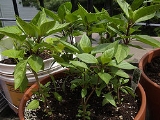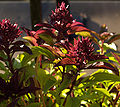
Thai basil
Encyclopedia


Basil
Basil, or Sweet Basil, is a common name for the culinary herb Ocimum basilicum , of the family Lamiaceae , sometimes known as Saint Joseph's Wort in some English-speaking countries....
native to Southeast Asia that has been cultivated to provide a distinctive set of traits. It has an identifiable licorice flavor not present in sweet basil, and its flavor is more stable under high or extended cooking temperatures than that of sweet basil. Thai basil exhibits small narrow leaves and purple stems, with a mauve (pink-purple) flower. One cultivar commonly grown in the United States
United States
The United States of America is a federal constitutional republic comprising fifty states and a federal district...
is 'Queen of Siam'.
Nomenclature and taxonomy
Sweet basil, Ocimum basilicum (O. basilicum), has multiple cultivars. Thai basil, or O. basilicum 'Horapha,' grows to 45 cm (1.48 ft) in height, and has purple-flushed lancelike leaves with a sweet licorice scent.The word Ocimum is derived from the Greek word meaning "to smell", which is appropriate for most members of the plant family Lamiaceae
Lamiaceae
The mints, taxonomically known as Lamiaceae or Labiatae, are a family of flowering plants. They have traditionally been considered closely related to Verbenaceae, but in the 1990s, phylogenetic studies suggested that many genera classified in Verbenaceae belong instead in Lamiaceae...
, also known as the mint family. Like other plants in the mint family, Thai basil features a square stem and the leaves always grow in pairs, opposite to each other and at 90 degree angles from the previous pair of leaves. There are over 40 cultivars of basil and this abundance of flavors, aromas and colors leads to confusion when identifying specific cultivars. For a detailed comparison, see Purdue University's O. basilicum research and Sunland Herb's anecdotal descriptions of basil, based on four historical resources.
Characteristics
There are three types of basil commonly used in Thai cuisine. Thai basil is the cultivar most often used for Asian cooking in Western kitchens. The English common name is Thai basil but in Thai kitchens, the plant is called "Bai Horapha" or simply horapha . Thai holy basil, also called "Bai Gka-prow" or kraphao, may be the basil that Thai people love most, is a variety of Ocimum tenuiflorum . The third species of basil found in Thai cooking is the least used and has undertones of lemon in both scent and taste. Thai lemon basil is called "Bai Maeng-lak" or simply maenglak .Basil is used in several different Asian cultures. Thai holy basil is a variety of Tulasi, which is worshiped in India and is also often called "Holy basil". Both Thai holy basil and Tulasi have smaller, softer, slightly hairy leaves and an aroma akin to that of cloves. In Vietnam, the most common basil cultivar with purple stems is called cinnamon basil and its name describes its flavor and scent. The Vietnamese cinnamon basil was known as húng quế (lit. "cinnamon basil").
Culinary uses
Although Vietnamese and Laotians also use the Asian varieties of basil in their cuisines, the purple-stemmed licorice-flavored leaves have come to be identified as Thai basil. It may be mistakenly called anise basil or licorice basil, but it is different than the Western strains bearing these same names. Horapha leaves are a frequent ingredient in Thai green and red curryRed curry
Red curry is a popular Thai dish consisting of curry paste to which coconut milk is added. The base is properly made with a mortar and pestle, and remains moist throughout the preparation process. The main ingredients are garlic, shallots, red chili peppers, galangal, shrimp paste, salt, kaffir...
(แกงเผ็ด), while the basil used in Thai Drunken Noodles and "Thai chicken/pork/seafood with basil leaf" is kraphao (Thai holy basil). Thai basil is also an important ingredient in the very popular Taiwanese dish, Three Cup Chicken. Used as a condiment, a plate of raw Thai basil leaves is often served as an accompaniment to phở
PHO
PHO may refer to:* Primary Health Organisation* Potentially hazardous object, an asteroid or comet that could potentially collide with Earth...
(Vietnamese-style noodle soup) so that each customer can achieve their own desired seasoning with the anise-flavored leaves.
See also
- List of basil cultivars
- List of Thai ingredients
- The particularly flavorful Thai basil is grown in LángLangLang may refer to:*Lang * "Langue" was Ferdinand de Saussure's term for what in contemporary linguistics is referred to as "competency " or "I-language" , referring to an idea of an internal cognitive "language" as distinct from surface forms —natural spoken language.-Places:Antarctica*Lang...
village, HanoiHanoiHanoi , is the capital of Vietnam and the country's second largest city. Its population in 2009 was estimated at 2.6 million for urban districts, 6.5 million for the metropolitan jurisdiction. From 1010 until 1802, it was the most important political centre of Vietnam...
and nearby. The Thai basil grown in this region is named "húng Láng".

